
Elijah Sofoluke
What: English Premier League
Who: Manchester United vs Arsenal
When: Saturday 3rd November, 2012, at 12:45 UK Time
Where: Old Trafford, Manchester, England
Fresh from hard-fought and controversial wins, Arsenal meet Manchester United at Old Trafford for a crucial Premier League clash. Both teams played in the League Cup during the week, but rested their key players this this game. The Gunners may not be the mammoth task for opponents they were during the era of Patrick Vieira, Thierry Henry and Dennis Bergkamp, but they will still cause problems for Manchester United.
Expected Line-up – Manchester United
Manchester United should make one change from the fiery affair at Stamford Bridge last Sunday, with Paul Scholes likely to come in for Tom Cleverley. Against Chelsea, Cleverley was found wanting when it came to keeping possession and was one of the main culprits, along with Ashley Young, for giving the ball back to Chelsea when they put Manchester United under immense pressure with 10 minutes to go before half time. The situation was similar to when the Red Devils were facing Newcastle, as they were 2-0 up and had been subjected to the first real pressure from the Magpies with half time approaching. However, that team held firm and were able to keep possession nicely, probably because of the extra man in midfield.
Expected Line-up – Arsenal
After their heroics in midweek against Reading, Arsenal should make eleven changes from that match and one from the game against QPR last Saturday. Olivier Giroud and Lukas Podolski switched between being the main man and the left wing during the QPR game. Against Manchester City, Gervinho and Podolski did that to a great effect while Arsenal played the 4-3-3, as during the game they changed to a diamond formation, which the Citizens found hard to handle.
Tactical Approach
Manchester United
Against Chelsea, Sir Alex Ferguson deployed a very astute tactical method that worked very well for the first 35 minutes of the game. In a similar vein to Tottenham under Andre Villas-Boas, he switched from a 4-1-4-1 when defending, to 4-3-3 while transitioning and 4-2-3-1 when attacking. Wayne Rooney, Antonio Valencia and Ashley Young were key to the shifts in formations and tactics.
In order to combat Chelsea’s attacking three, Valencia, Rooney, Cleverley/Scholes and Young would stand off their opponents when they had possession in front of them. The space between the midfield and defence was very compact, making it difficult for Eden Hazard, Juan Mata and Oscar to operate as they usually do. When the Red Devils were in possession of the ball, Valencia and Young occupied positions further up the pitch, pushing the Chelsea full backs back. Rooney and Cleverley squeezed the play by pushing forward, but not too far forward and Michael Carrick still occupied the zonal space. When the ball reached the feet of Robin van Persie or the attacking wingers in their attacking positions, Rooney would join the attack. Carrick would push up to make a two with Cleverley and they sat deep as a double pivot. If the ball was lost, then they reverted to the defensive positions. A similar style may be employed against Arsenal here.
Arsenal
Assistant manager Steve Bould has been attributed with enabling the success of the Arsenal defence early on in the season, but it has shown to be less than secure as the games have come thick and fast. A similar situation occurred a few seasons ago with Arsenal using pressure to get the ball back. At the beginning of the campaign, what was seen was the result of planning during pre-season, with a high pressing game being worked on to win the ball higher up the pitch, closer to the opposition’s goal and not nearer the defence. However, this tactic has only seemed to be in action during the early parts of the season, with the attackers and the midfielders no longer wanting to pressurise the ball higher up the pitch.
The 4-2-3-1 Arsenal play now only needs a pressing game from the three attackers behind the main striker. Chelsea showed against Manchester United what happens when the double pivot decide to press the ball because it was they who left the spaces in behind for the Red Devils to exploit. Mikel Arteta and Jack Wilshere will either have to sit deep and rely on their attacking players to put the fragile Manchester United defenders under pressure, or while without the ball, change to a 4-3-3, where Wilshere and Santi Cazorla press the ball together.
Key Area – Extra Man in Midfield
This game, in particular, will put extra emphasis on the number 10s in either side to get back and support their midfield when the other team has the ball. Rooney showed his worth in this position during his 74 minutes at Stamford Bridge on Sunday. He may have conceded the free kick that led to the first goal for Chelsea, but other than that, the England man was sublime in his work ethic and output for the team as a whole. Cazorla will have to perform a similar role to Rooney otherwise Wilshere and Arteta will have a tough battle on their hands against a three-man midfield of Carrick, Scholes and Rooney.
Tactical Prediction
In a sense, it matters whether one team has the more of the possession or not. If Manchester United are in charge of the ball, then it is likely that they will cut Arsenal to pieces, as that is what usually happens when Ferguson’s men are on their game. On the other hand, Arsenal having the more of the possession could result in a win for Manchester United or Arsenal. This is because of the Red Devils’ ability to win games without playing well, enhanced by their prominent attacking four. This does not point to a rout in favour of Manchester United, but a more modest score seems likely. Manchester United 3-1 Arsenal.
Ready to use your tactical knowledge? Visit Inside Bet and pick the best bet from our Man Utd v Arsenal betting preview.












